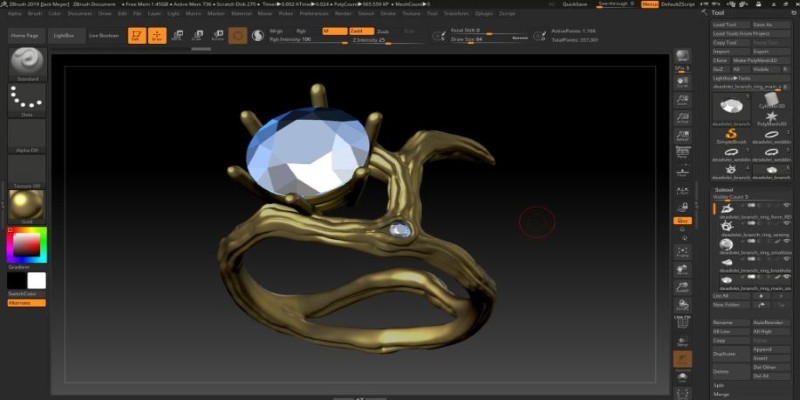When people hear "3D modeling," they often think of animated movies, video games, or detailed architectural designs. Yet, many aren't clear about what it really involves. Simply put, 3D modeling is creating digital three-dimensional versions of objects using specialized software, ranging from simple shapes like cups to complex designs like cars or human figures.
Similar to digital sculpting, artists start with basic shapes, refine them, and add textures to create lifelike images. This technology extends beyond entertainment, significantly influencing fields such as medicine, engineering, and education. Understanding 3D modeling requires exploring the processes, tools, and techniques behind this powerful digital art.
How Does 3D Modeling Work?
The process of 3D modeling starts with the virtual canvas—a workspace within software designed specifically for creating digital objects. Typically, artists begin by selecting a basic shape, known as primitive, like cubes, spheres, cones, or cylinders. These simple structures form the foundational blocks for more intricate models. By manipulating vertices, edges, and polygons, the artists shape and refine the primitive into the desired object.
In practice, imagine sculpting with clay, except you're doing this digitally. With clay, you'd use tools to mold, carve, smooth, and cut; similarly, digital artists use software tools to extrude, scale, rotate, and detail their virtual clay. After constructing the main structure, textures and colors are applied to create realism. Lighting is then adjusted to emphasize details, shadows, and highlights, making the model look convincingly real. Finally, rendering brings everything together—turning raw digital geometry into polished visual outputs, either static images or animated scenes.
What makes 3D modeling so versatile is its capacity for precision and customization. Artists can zoom, rotate, and scrutinize every angle and detail. Mistakes can be easily undone and corrected, allowing artists and designers an enormous degree of flexibility that physical methods simply can't match.
Popular Techniques in 3D Modeling
To truly appreciate 3D modeling, one should explore the various approaches artists use to craft their digital creations. One common method is polygonal modeling, a straightforward yet powerful technique. In polygonal modeling, shapes are built using flat surfaces (polygons), usually triangles or quadrilaterals. These polygons connect to form complex shapes, allowing artists immense flexibility and precision.

Another popular technique is sculpting. This method resembles real-world sculpture, providing an intuitive approach ideal for organic shapes and complex details, such as human faces, animals, or intricate decorative designs. Software like ZBrush or Blender allows artists to push, pull, pinch, or smooth digital material, just as traditional sculptors manipulate clay.
A third widely utilized method is parametric modeling, commonly used in industrial design and engineering. Parametric modeling involves the use of mathematical equations and parameters, making it ideal for designs where precision, scalability, and repeatability matter greatly. Engineers rely on software like SolidWorks and AutoCAD to create detailed mechanical components, assembly models, and architectural plans.
Each modeling technique has unique strengths, and artists often combine methods based on the project's requirements. This adaptability enables 3D modeling to be effective across diverse scenarios—from playful animation to precise mechanical design.
Tools of the Trade: Essential 3D Modeling Software
As 3D modeling has gained popularity, numerous software tools have emerged, catering to a broad spectrum of users and their unique needs. Blender, for example, is a versatile, free, open-source program appreciated by both beginners and experienced users for its broad capabilities in animation, game development, visual effects, and architectural visualization. Autodesk Maya, another industry leader, is highly regarded in the professional animation and film industries due to its powerful animation features and advanced rendering tools, making it a go-to choice for movie creators and game developers.
Cinema 4D is popular in the motion graphics and visual effects communities, especially in commercial and broadcast work, thanks to its intuitive interface and robust capabilities. For artists who prefer a more traditional approach, ZBrush offers exceptional sculpting tools, allowing detailed and realistic organic forms, from human figures to intricate decorations.
On the engineering and industrial side, parametric modeling software such as SolidWorks, Autodesk Inventor, and AutoCAD are widely used. These programs offer precision and accuracy, making them ideal for product design, mechanical engineering, and architectural planning. Additionally, SketchUp is highly valued for its simplicity, enabling users to quickly create conceptual designs without a steep learning curve.
Choosing the right software depends heavily on project specifics, budget considerations, and the user's experience level. Numerous tutorials and online communities support this process.
Applications and Importance of 3D Modeling Today
3D modeling's practical benefits are tangible across a vast spectrum of industries. In entertainment and media, it powers blockbuster films, animated series, and interactive video games, bringing complex and imaginative worlds to life. Animators rely on realistic and expressive models to portray emotions and actions convincingly, immersing audiences like never before.

In architecture and real estate, 3D modeling has become invaluable. It provides highly detailed virtual walkthroughs and renderings of buildings, landscapes, and interiors before construction even begins. This visualization dramatically improves communication, minimizes misunderstandings, and saves resources by detecting potential issues early.
The medical field benefits from precise 3D models of human anatomy for training and surgical preparation. Surgeons use these digital representations to rehearse complicated procedures, visualize patient-specific anatomy, and significantly reduce risk during operations.
Likewise, manufacturing and engineering heavily depend on detailed, accurate 3D models to design, test, and optimize components. Models enable rapid prototyping, reduce production times, and enhance product quality by allowing extensive testing in a virtual environment.
Beyond these practical uses, 3D modeling has a significant role in education. It allows students to visualize complex scientific concepts, historical artifacts, and artistic ideas in three dimensions. As technology advances, the relevance and scope of 3D modeling will only continue to grow.
Conclusion
3D modeling is more than just digital artwork—it's a transformative tool shaping our world in exciting ways. From the dazzling visuals in movies and video games to groundbreaking advancements in medicine and architecture, its impact is everywhere. Understanding this powerful technique reveals opportunities for creativity, innovation, and practical solutions across industries. As technology progresses, mastering the basics of 3D modeling will not only unlock endless possibilities but also keep us connected to cutting-edge developments that will shape our future.
